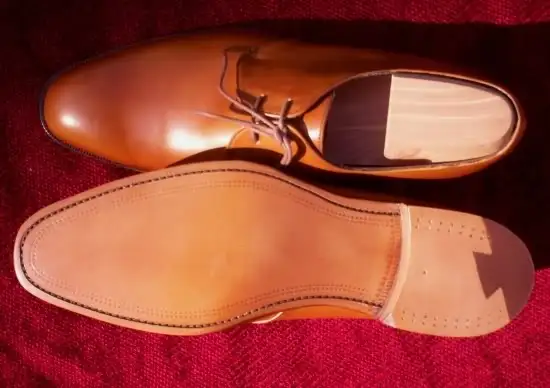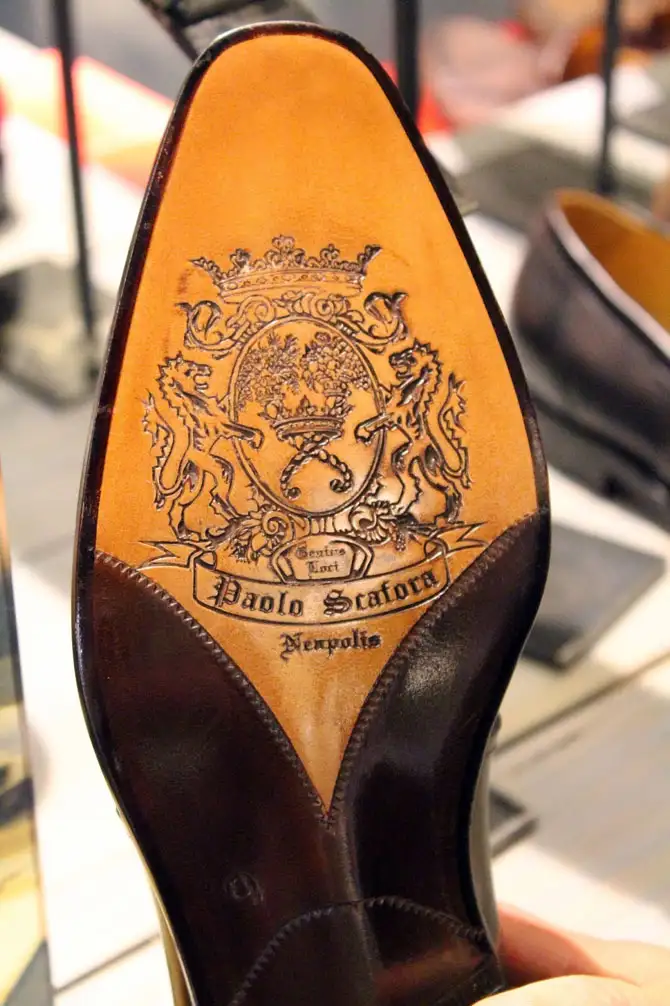
There are many different treatments that one can give to a shoe’s sole, but what I want to focus on is the big obvious one, i.e. channel stitching. There are really only two ways to do it (in the modern world of RTW shoes), which is either open (showing) or closed (not showing). What you find as a general rule is that the lower end the brand, the more chances are that they will have an open stitched channel while the higher end brands will usually go for the closed stitch. In reality there is nothing that gives or takes away from the shoe by doing either one. It is actually more simply a matter of elegance and creating a clean vs. rough(er) look, which is why the high end makers go for the much more clean looking closed channel.

There are things that one should know however when it comes to the differences, both good and bad. So let’s take a look at those.
Open Channel
-What is it? The channel, full stop, is the little trench like opening that holds the stitching that connects the sole and the welt. When it is ‘open’ that means that it is showing when you look at the bottom of the sole. The manufacturer simply stitches the sole onto the welt and the machine will create the channel as it is stitching each stitch.
Positives:
1. It’s easy to repair.
2. It keeps the costs lower to your shoes
3. It is straight forward
Negatives:�
1. In rare cases, the stitch can rip if worn too long without repair. Another rare case is that water can possibly seep through on a botch job.
2. It’s not always that nice looking.
3. A good maker will actually create a trenched (sunken) channel, while a bad maker will not. The ones that don’t make the sunken channel will be more likely to come undone as the stitching gets more exposed to the pavement/concrete.

Closed Channel
-What is it? A closed channel is when the manufacturer, instead of simply creating the stitch and the channel at the same time, first cuts into the sole to create a little flap of leather that they can then lift up. Once this is cut and lifted up, they then cut the channel and stitch the sole to the welt. After this it is closed back down and glue is used to keep it down, thus creating a uniform surface without anything showing on it.
Positives:
1. It gives a nice clean look to the sole. It’s elegant, tidy and ultimately shows a higher level of craftsmanship.
2. As the channel is closed, it protects the sole from water coming though that might do on an open one.
Negatives:�
1. As the leather that hides the channel is a thin piece that has only been glued down, it can either be undone by excess water/moisture/liquid etc. and thus lift back or can be broken through stepping on rocks or other strong, rigid things. When it breaks, it can leave little chunks of missing leather flaps, which is not nice to see. More often than not, this will occur as many of us walk constantly on concrete, wet surfaces and for those of us in Europe, on cobblestone
2. The rougher the surface you walk on (i.e. cobblestone), the more likely the flap will get pulled back (as you nick your toes) and thus expose the channel.

It is important to note that just because a shoe is expensive and has given the sole a closed channel treatment does not mean that it will be indestructible. Get this immediately out of your head. Even the best sole in the world, with the best closed channel job done can be undone if you kick your toes hard enough on the concrete, a step on a staircase, or a million other things that we do to wreck our soles. This is one of the benefits of the open channel. You don’t notice the wear and tear as much. So you have to choose your battles. But do so wisely.













Keep them irrelevant photos coming mister! 🙂
I do have one interesting (maybe not) observation that is for the same price range an Italian shoemaker would have closed channel blake stitching whereas an English shoemaker would not have closed channel Goodyear stitching (think Gucci vs C&J Becnhgrade) Any reasons to why is that the case?
because the cost of blake is less than goodyear so it balances out….but you can’t compare Gucci to C&J benchgrade….Gucci’s profit margin is way higher….part of that retail price is name alone, not cost of goods sold.
Hi Justin, the Saint Crispin’s have something to do with the post. They have a closed stitching 🙂 Greetings to you…..
Your work is beautiful can a pair of theses shoes be bought
Thanks for this post Justin. My first hand experience with “better” shoes is quite limited, my GY welted shoes have been Alden or Allen Edmonds — both open channel. It wasn’t until I began learning more about truly better shoes on your site that I discovered the closed channel treatment.
I will say that the fancy designs shown on some of the pictures you’ve posted (showcasing closed channel soles, sometimes with artful designs) seem sort of silly. All that lovely art work won’t look so good once the shoes are worn in and the soles are scuffed up a bit — right?
glad that you enjoyed it. Yes you are right….fancy designs on the sole usually on the forefoot, will be destroyed after several wears…but that is really neither here nor there….art is art I guess…. I really don’t like modern art, but people buy it and appreciate it…even if it is just a splash of paint on canvas..I don’t see the point to it, but there must be one
Great post and explanation…but who makes those tan bluchers in the “open channel” example?
sorry arthur for this obscenely late reply…to be honest, I have no clue who made those…think that they were a re-sole hence why I can’t place the maker
always a wonderful read Justin. You are a good teacher.
Thanks Johnny!
How good are To Boot New York shoes in relevance to price and construction? Are they well made, decent quality, lasting shoes?
So glad I stumbled across the Shoe Snob and Justin Fitzpatrick. I have learned so much through these articles and have purchased a few items from you. Look forward to future purchases and more education about dress shoes!